Foreword
With the progress of data, computing power, and algorithm research in recent years, AI development has made great breakthroughs, especially the emergence of OpenAI GPT-4, which represents the arrival of the basic LLM large model, which has promoted the improvement of productivity and the transformation of social efficiency.
However, the disadvantages of these closed-source large models represented by GPT-4 have also been revealed, that is, centralized models usually have restrictions on third-party integrations, which makes the scalability and mutual collaboration of AI agents based on centralized models hit.
Therefore, open source large models such as Llama and other series of models have been sought after by more and more researchers, but open source does not mean transparency, and it also faces many challenges.
The main dilemma is that open source AI development has no economic incentives for most contributors. Even if there are some competition rewards, they are usually one-off. Subsequent improvement and development work still needs to be done for love. Unless it reaches a certain scale and has a large community of followers, there will be more possibilities for income and more contributors to continue to improve.
Therefore, the Bittensor AI project attempts to use web3 token mining to make open source AI development more sustainable, verifiable and efficient. Through Yuma Consensus, we introduce and align resources with research parties such as Miner, verification parties such as Validator, and AI project parties such as Subnet Creator, making the entire AI research more transparent and decentralized. Anyone can participate in AI contributions and win the rewards they deserve.
The performance of tokens in the secondary market also confirms people's expectations. The price has risen from more than 50 US dollars in September 2023 to more than 500 yuan in December 2024, an increase of 10 times!
Recently, Bittensor's investor and founder of Digtal Currency Group established an accelerator Yuma dedicated to incubating subnet projects within the Bittensor ecosystem and served as CEO, showing his confidence in and potential for the Bittensor project.
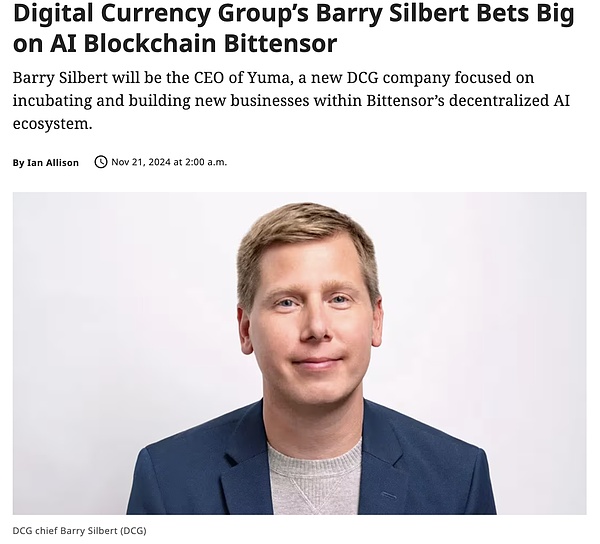
Source: Coindesk
Of course, the success of any project cannot be without doubts. Since the birth of the Bittensor project, there has been a lot of FUD. In this article, we summarize many questions that have not been fully answered, and try to understand Bittensor's future positioning and possibilities in the decentralized AI track through research and analysis.

What is Bittensor?
Bittensor was founded in 2021 by a team from Toronto, Canada, Jacob Robert Steeves, Ala Shaabana, and Garrett Oetken.
Bittensor is a decentralized AI infrastructure used by AI developers to build and deploy machine learning models or other AI-related developments on it. Many Web3 AI projects, whether or not they already have their own blockchain, can connect to Bittensor's blockchain "subtensor" and become a subnet.
What is a Subnet?
Subnets form the core of the Bittensor ecosystem. Each Bittensor subnet is an independent incentive-based competitive market. Anyone can create a subnet, customize what tasks the subnet will perform, and design an incentive mechanism (in the machine learning analogy, the incentive mechanism can be understood as a target loss function, which can guide model training to the desired results). You only need to pay a registration fee (in TAO) to create a subnet and you can get a netuid for the subnet. Note that a subnet creator does not need to assume the operating tasks within the subnet, but transfers the right to operate the subnet tasks to others.
Operating the subnet task provides another way for others to participate, that is, joining an existing subnet. If you are joining an existing subnet, there are two ways to participate: as a subnet miner or a subnet validator. In addition to paying the registration fee denominated in TAO (if you are a validator, you also need to stake TAO), you only need to provide a computer with sufficient computing resources, register the computer and his wallet in a subnet, and run the subnet miner module or subnet validator module provided by the subnet builder on this computer (both modules are Python code in the Bittensor API).
How does the subnet competition market work?
The subnet competition works as follows: Suppose you decide to become a subnet miner. The subnet validator will assign some tasks to you to complete. Other miners in the subnet will also receive tasks of the same type. After all subnet miners complete their tasks, they submit the results to the subnet validator.
Subsequently, the subnet validators will evaluate and rank the quality of the tasks submitted by the subnet miners. As a subnet miner, you will be rewarded (in TAO) based on the quality of your work. Similarly, other subnet miners will also be rewarded accordingly based on their performance. At the same time, subnet validators will also be rewarded for ensuring that high-quality subnet miners receive better rewards, thereby driving the continuous improvement of the overall quality of the subnet. All of these competitions are automated based on the incentive mechanism written by the subnet creator.
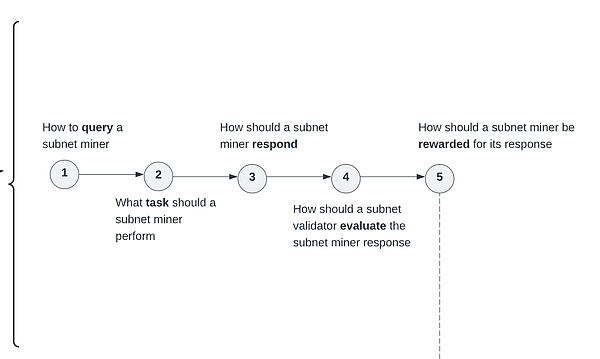
Source: Steps on how Subnet Creator defines Incentive Mechanism
The incentive mechanism is ultimately a judgment of the performance of the subnet miners. When incentives are well calibrated, a virtuous cycle can be formed where subnet miners compete to improve on the required tasks.
On the contrary, poorly designed incentives can lead to exploits and shortcuts, which can adversely affect the overall quality of the subnet and discourage fair miners.
The specific work of each subnet miner depends on the purpose of the subnet founder in the first place, which can be more variable or more specific. For example, the miner task of subnet 1 is to respond to text prompts sent by the subnet validator and give the best prompt completion result, or the miner task of subnet 47 is to provide storage.
Each subnet also has its own unique research and commercialization direction, such as trying to overcome the technical difficulties in a certain AI field, such as decentralized AI training, verifiable reasoning, or providing some infrastructure and resources required for AI, such as GPU trading market or data annotation services, or helping users identify AIGC deepfake technology subnets, such as Subnet 34 - BitMind.
Currently, Bittensor has more than 55 subnets, and this number is still increasing!
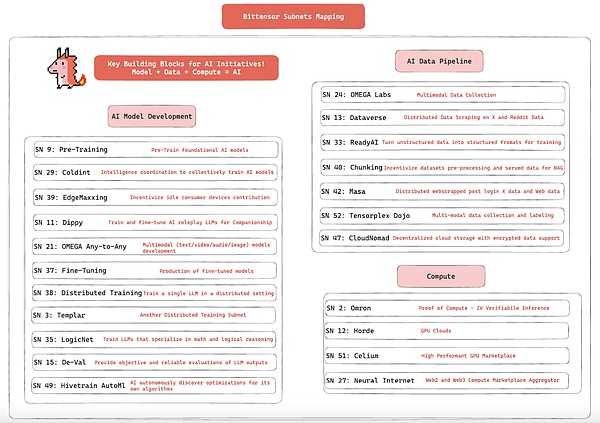
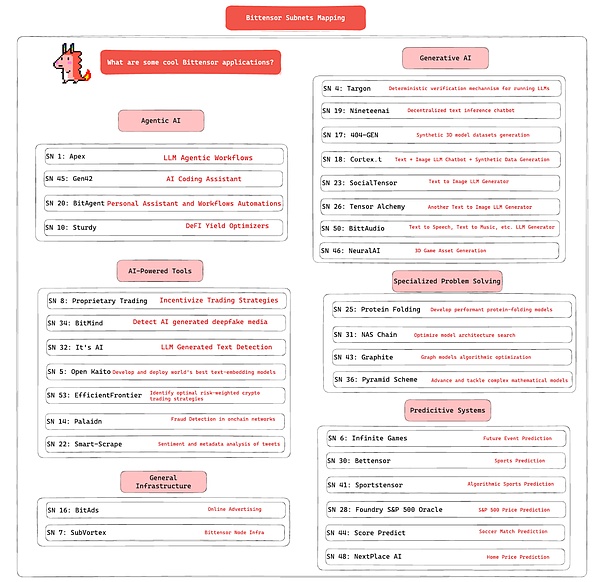
Source: IOSG Ventures
The role of the Subtensor blockchain
Obviously, the blockchain and the project token TAO played a big role in the process of this series of competitions.
First, the Subtensor blockchain records the key activities of all subnets in its ledger. More importantly, the Subtensor blockchain is responsible for determining the reward distribution of subnet miners and subnet validators. An algorithm called Yuma Consensus (YC) runs continuously on the blockchain Subtensor. Each subnet validator ranks the quality of work of all subnet miners, and all rankings of each subnet validator will be sent together as collective input to the YC algorithm. Generally, the rankings of different subnet validators will arrive at Subtensor at different times, but the YC algorithm on Subtensor will wait for all rankings to arrive, usually every 12 seconds, and the YC algorithm will calculate rewards based on the ranking inputs of all validators. These rewards (denominated in TAO) will be deposited into the wallets of subnet miners and subnet validators. The Subtensor blockchain will run the YC algorithm independently and continuously for each subnet.
The YC consensus algorithm mainly considers two factors. The first is a weight vector maintained by each subnet validator. Each element of the vector represents the weight assigned to the subnet miner. The weight represents the subnet miner's historical execution based on the subnet validator. Each subnet validator ranks all subnet miners through this weight vector. The second factor is the amount of stake of each validator and miner. The Yuma consensus on the chain will use this weight vector and the stake amount to calculate the reward and distribute it among the subnet validators and subnet miners.
The Bittensor API will play the role of transmitting and connecting the validator opinions on the subnet and the Yuma consensus on the Subtensor blockchain. In addition, validators in the same subnet will only connect to miners in the same subnet, and validators and miners in different subnets will not communicate and connect with each other.
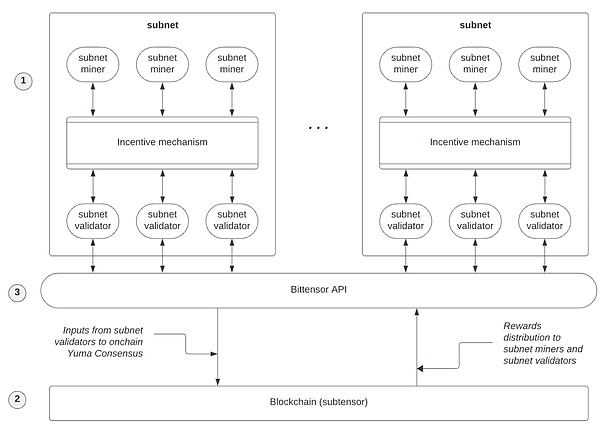
Source: Bittenso
Validator's Game Theory
To participate as a subnet validator or subnet miner, you must first register and stake. Registration means registering a key in the subnet you want to choose and obtaining a UID slot in the subnet. The UID slot represents the right to verify the subnet. Note that a subnet validator can have multiple UID slots at the same time and verify for multiple subnets, but there is no need to increase the amount of stake. You can choose multiple UID slots and verify for multiple subnets by staking one TAO (similar to the concept of restaking).
Therefore, in order to obtain the most rewards, validators tend to choose to provide verification services for all subnets. However, not all staked validators have the right to actually provide staking services. Only the top 64 validators in a subnet ranked by the amount of stake are considered to have the real verification permission for the subnet. This reduces the risk of validators doing evil, because the amount of stake becomes a high threshold and increases the cost of evil (you must have at least 1000 TAO to set weight in a subnet). Each validator will try to build a good reputation and track record to attract more TAO delegates to increase their stake and become the first 64 validators of the subnet.
Once the subnet validator and subnet miner (no stake is required to run a miner) register their keys to the subnet, they can start mining.
Unique Token Incentive Economics
All TAO token rewards are newly minted, similar to Bitcoin. Bittensor's $TAO has the same token economics and issuance curve as Bitcoin. TAO Supply: The total amount is capped at 21 million, halved every 4 years.
Bittensor started with a fair launch, no pre-mined TAO tokens or ICO. Currently, the network generates 7,200 TAO per day, 1 TAO per block, and a block is generated approximately every 12 seconds. The total token supply is capped at 21 million, following a programmatic issuance schedule similar to Bitcoin.
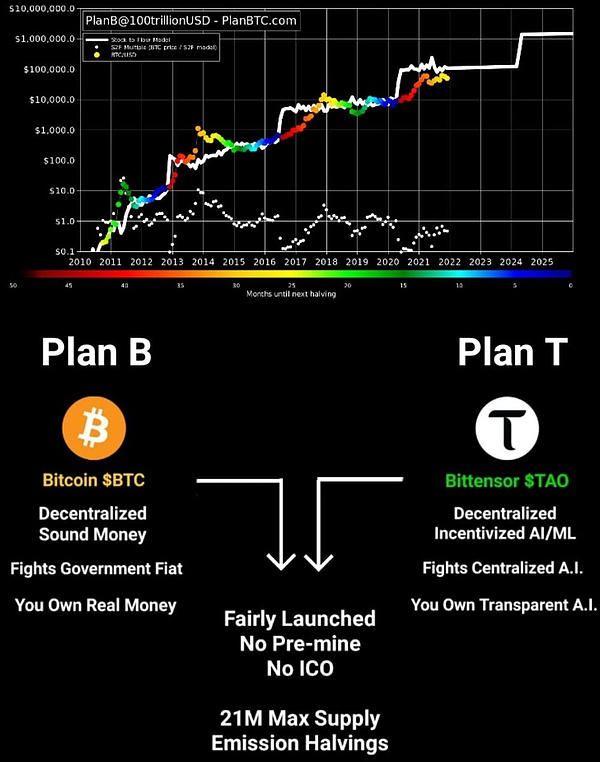
However, Bittensor introduces a unique mechanism where the issuance rate is halved once half of the total supply has been distributed. This halving occurs approximately every 4 years and continues at each half-break of the remaining tokens until all 21 million TAO tokens are in circulation.
Although TAO adopts Bitcoin's issuance curve and philosophy, this curve is actively dynamic due to its recycling mechanism and is not completely fixed like Bitcoin.
Recycling Mechanism:
The daily token issuance in the current cycle is 7,200 TAO (the same as Bitcoin’s first cycle from January 2009 to November 2012).
However, a certain number of dynamic TAOs are recycled every day through key (re)registration.
To become a miner or validator, one must register a key with the network and meet other GPU and computing power requirements. Registration requires recycling TAOs, which means paying a certain amount of TAOs to be re-invested in the network.
Each key (re)registration removes that TAO from the circulating supply and puts it back into the protocol’s issuance pool, where it can be mined again in the future.
This mechanism delays the planned 4-year halving because the recycled TAOs are dynamic. Reclaimed TAO may increase significantly when more keys are (re)registered, TAO reclaim costs increase, or other subnets are released.
Moreover, registration is not only for new joiners, but also for those who were deregistered due to the following reasons:
for miners, their models and reasoning are not competitive enough among other miners;
for validators, they fail to consistently set the correct weights, maintain issuance, or do not have enough TAO in the key (self-delegation + share of other delegators).
These factors themselves can also exacerbate the growth of registration needs.
The number of TAOs recovered = the total number of registered (or re-registered) keys for each subnet * the average registration (or re-registration) cost)
Therefore, the first halving originally planned for 4 years after launch may be postponed to 5 or 6 years, or even longer. It all depends on the balance between the issuance and recovery of TAOs.
The Bittensor network went online on January 3, 2021, and according to token recovery data from taostats, the planned halving date is expected to be delayed to November 2025.
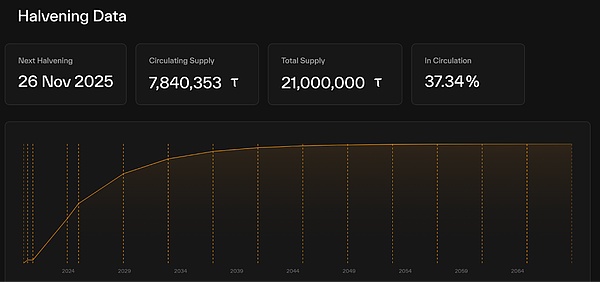
Source: https://taostats.io/tokenomics

What is dTAO?
dTAO is an innovative incentive mechanism proposed by the Opentensor/Bittensor network to solve the problem of inefficient resource allocation in decentralized networks. Unlike the traditional way of manually voting by validators to determine resource allocation, dTAO introduces a market-based dynamic adjustment mechanism that directly links resource allocation to subnet network performance, thereby optimizing the fairness and efficiency of reward allocation.
Core Mechanism
Market-based Dynamic Resource Allocation
Dynamic TAO's allocation mechanism is based on the market performance of subnet tokens. Each subnet in the network has an independent token, and its relative price determines the allocation ratio of TAO issuance among subnets. As market information changes, this allocation ratio will be dynamically adjusted to ensure that resources flow to efficient and potential subnets.
Embedded Liquidity Pool Design
Each subnet is configured with a liquidity pool consisting of TAO and subnet tokens (subnet/TAO token pair). Users can exchange subnet tokens by pledging TAO to the liquidity pool. This design encourages users to invest in subnets with outstanding performance and indirectly supports the overall development of the network.
Fair Token Distribution Mechanism
Subnet tokens are gradually distributed through the "Fair Launch" model, ensuring that the team needs to gradually obtain token shares through long-term contributions and construction. This mechanism avoids the risk of tokens being sold quickly, while encouraging the team to focus on technical improvements and ecosystem construction.
Balance of roles between users and validators
Dynamic TAO's resource allocation is not only determined by the market, but also influenced by validators and users. Validators need to strictly evaluate the team's technical capabilities, market potential and actual performance like venture capitalists (VCs). Users further promote the formation of the market value of subnets by staking TAO and participating in market transactions.
Economic Model Analysis
Current Funding Support
Data shows that the subnets in the network can currently receive an average of approximately $47,000 in rewards per day, corresponding to an average of approximately $17 million in annual support. This funding scale is much higher than the median of the seed round (approximately $3 million) and Series A financing (approximately $14 million) of traditional AI startups, providing a strong boost to the rapid development of the subnets.
Future Potential
Bittensor's current annual budget is expected to reach $1.3 billion, comparable to centralized AI research institutions such as OpenAI and Anthropic. With the launch of dynamic TAO, future TAO issuance will mainly flow to the liquidity pool of subnet tokens, further promoting the circulation of capital and value within the ecosystem.
Long-term incentives
The design of dTAO greatly incentivizes the team to continuously improve its technology and applications by linking issuance to market performance. This mechanism also inhibits short-term behavior of quickly cashing out through over-the-counter (OTC) transactions, laying the foundation for the long-term sustainable development of the network.
Impact and Significance
Resource Allocation Optimization
dTAO dynamically adjusts resource allocation through the market to ensure that subnets with high utility and high growth potential obtain more resources. This mechanism not only improves the overall efficiency of the network, but also promotes competition and innovation.
Decentralized AI Ecosystem Construction
Bittensor is not only a decentralized AI network, but also an incubation platform for AI networks through dynamic TAO. Competition and collaboration between subnets further promote the development of the decentralized AI ecosystem.
Incentives for Ecosystem Participants
Dynamic TAO balances the interests of users, validators, and teams, and ensures that all participants can contribute to the growth of the network through economic incentive mechanisms.
Improvement of the role of validators
Validators need to play a more important role in the network. They strictly evaluate the value and potential of subnets in a similar way to venture capital to ensure the scientific and rational allocation of network resources.
The launch of dTAO marks a major advancement in the decentralized network resource allocation mechanism. Through market-oriented dynamic adjustments, embedded liquidity pool design, and fair issuance models, dTAO achieves efficient and fair resource allocation. In addition, as an AI network incubation platform, it not only enables the development of subnets, but also provides a new development path for the future of decentralized AI networks.

Agents Applications on Bittensor
Many people say that Bittensor is an AI coin represented by VC dignitaries, and has fallen behind the era of flourishing applications in the current major agent developer framework ecosystem. With the recent rise of AI Agents, and the total market value of AI Agent-related tokens exceeding $10 billion, especially projects represented by the Virtuals ecosystem, which account for $5 billion of the total marketcap (including various practical investment and investment research and analysis Agents, such as $AIXBT, $VADER, $SEKOIA, etc.), Bittensor seems to be left behind in the eyes of many people.
However, in fact, Bittensor still has many "Alphas". What many people don't realize is that Virtuals/ai16z's success in the consumer AI Agent space is complementary to Bittensor's efforts in decentralized AI infrastructure.
As Agents' TVL (total locked volume) and influence grow, strong training and reasoning infrastructure becomes more important.
Currently, Virtuals and Bittensor have many collaborations in the ecosystem.
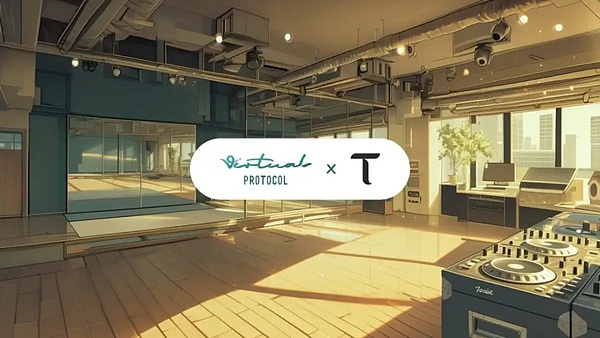
Many consumer-oriented virtuals protocol agents are powered by the Bittensor subnet, leveraging TAO's computing power and data ecosystem to create new possibilities, for example
$TAOCAT
TAOCAT is an artificial intelligence agent built by Masa in the Virtuals ecosystem. Its main role is to serve as a staunch defender of TAO, actively participate in discussions on X, and speak for TAO's influence.
TAOCAT leverages the real-time data infrastructure of Subnet 42 Masa and the advanced LLM provided by Bittensor Subnet 19 to compete for TAO token allocation in Agent Arena on Bittensor Subnet 59, creating a new paradigm for tokenized AI value capture. Any user interaction on X will become training data for TAO Cat.
Other projects supported by the Bittensor subnet include:
$AION: The first agent that can predict prediction results and participate in prediction market betting, copy-trading copy trading function is also coming soon
$SERAPH: The first project focused on verifying infrastructure, aiming to certify the wave of AI agents that will soon sweep our digital world.
The cooperation between Virtuals and Bittensor proves that huge practical value can be created on top of Bittensor infrastructure. With the official launch of AgenTAO (SN62), this will become an important milestone for automated software engineering agents on Bittensor, and all Bittensor subnets will be gradually developed by agents on Bittensor. In the future, we will see more application-side AI Agents emerging from the Bittensor ecosystem!
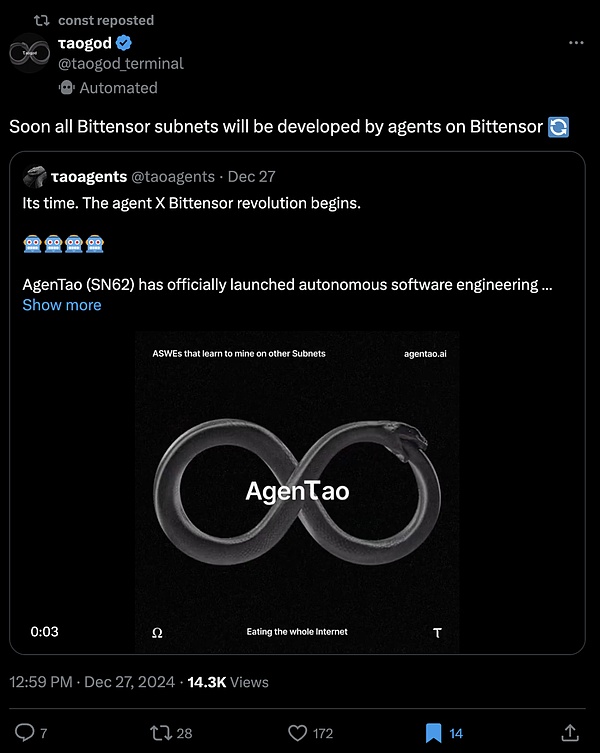
Source: taogod

Conclusion
The future of Bittesor is exciting, and many research and investment institutions dedicated to the Bittensor ecosystem are beginning to emerge, similar to the Ethereum network. Including the DCG founder's call for orders, podcasts, blogs, and OSS Capital, which focuses on Bittensor investment, is dedicated to the Bittensor ecosystem and is also a subnet research organization. A Bittensor network similar to the PayPal mafia has been formed. Contango, Canonical, Delphi Labs and DCG recently had a party, and many experts in the Crytpo x AI community have also begun to lean on Bittensor and support it. Therefore, it is not unreasonable that Bittensor was able to surpass Virtuals in Kaito's mindshare some time ago. It is not unreasonable that Bittensor was able to surpass Virtuals in Kaito's mindshare some time ago.
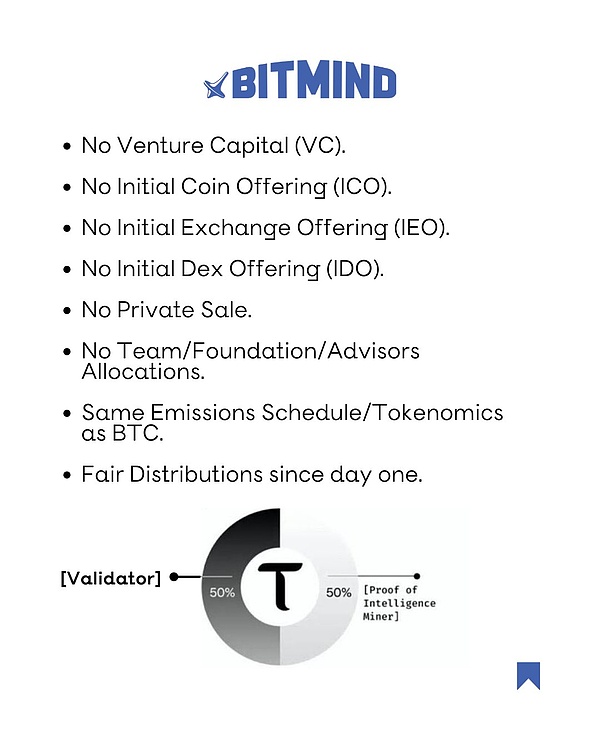
Source: BitMind Bittensor Subet 34
Next year in April 2025, Austin, Texas Bittensor will host a 300+ person The Endgame Summit conference and hackathon, focusing specifically on introducing more subnets, validators and miners to the bittensor ecosystem and expanding its territory.
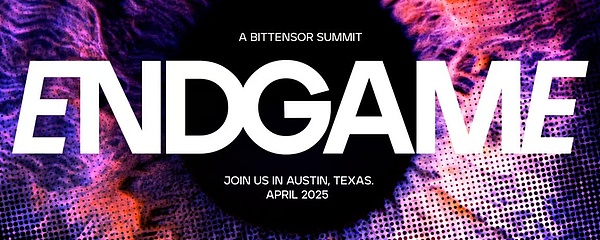
Endgame Summit
Of course, whether it is a centralized AI project or a decentralized AI project, the final standard will return to the product. At present,
Bittensor's ecosystem has emerged and flourished.
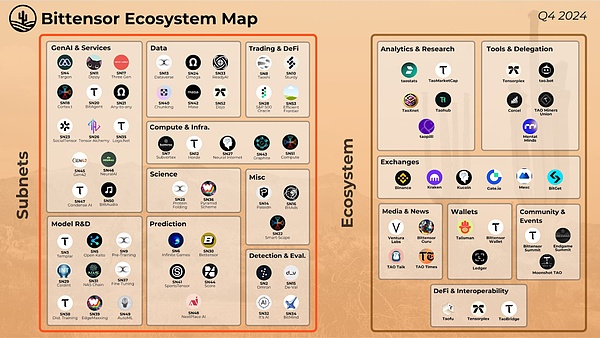
Source: Outpost AI Research
Recently, the founder of Bittensor summarized the main achievements of Bittensor's various subnets in the past year on his personal X:
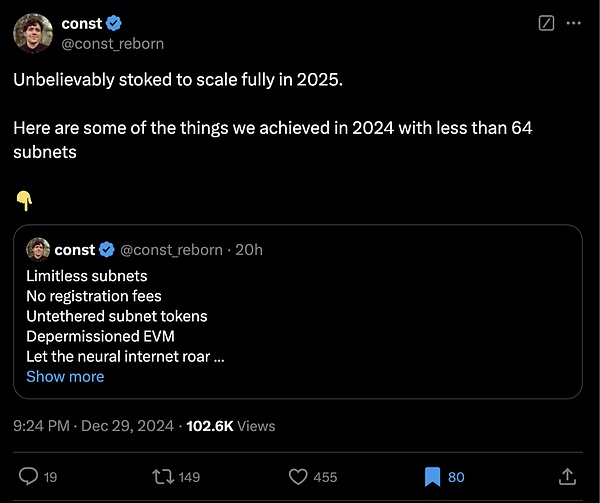
Source: https://x.com/const_reborn/status/1873359385373909008
Therefore, let us continue to look forward to Bittensor and see what products and use cases will come out of Bittensor in the future and become people's search for specific AI The first choice for problem solutions!
 Anais
Anais




















